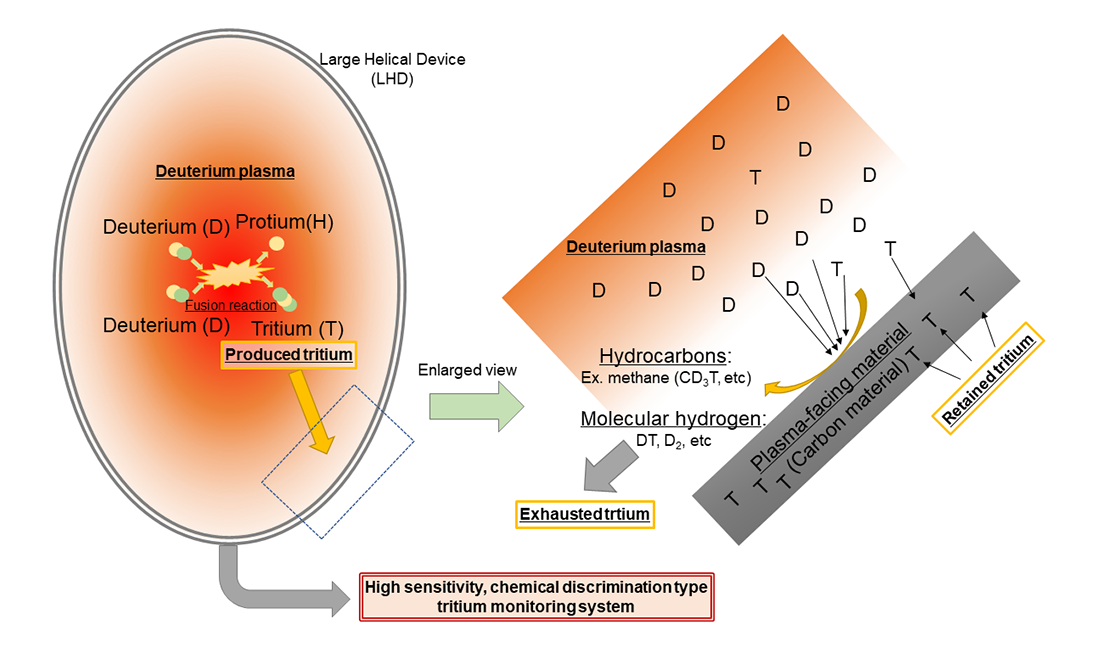Explore the behavior of hydrogen isotopes using a tracer
Hydrogen isotopes' behavior in a fusion test device has been clarified by use of a small amount of tritium, that was produced in deuterium plasma using the LHD as a tracer. Furthermore, it was clarified that the tritium released from the plasma-facing materials in the LHD is governed by hydrogen isotope exchange reactions and diffusion in the material. These results provide valuable knowledge on the safe handling of tritium and the fuel cycle system in future fusion reactor systems.

Hydrogen isotopes' behavior in a fusion test device has been clarified by use of a small amount of tritium, that was produced in deuterium plasma using the Large Helical Devices (LHD) as a tracer. Furthermore, it was clarified that the tritium released from the plasma-facing materials in the LHD is governed by hydrogen isotope exchange reactions and diffusion in the material. These results provide valuable knowledge on the safe handling of tritium and the fuel cycle system in future fusion reactor systems.
Understanding the behavior of hydrogen isotopes used as fuel in future fusion reactor systems is one of the key issues from the viewpoints of fuel balance and safety management of the systems. Thus, we proposed a tracer technique to evaluate the mass transfer process of hydrogen isotopes in the system and used a small amount of tritium produced in the deuterium plasma by the Large Helical Device (LHD) as a tracer.
To measure low concentration tritium, we have developed a measurement system that can differentiate the chemical form of hydrogen isotopes with high sensitivity. Due to their chemical properties, hydrogen isotopes can take various chemical forms, such as molecular, water vapor, and hydrocarbons. These chemical forms are differentiated by using the difference in temperature at which they are oxidized by the catalyst. In addition, by collecting tritium in water over a certain period, we were able to achieve a measurement of lower tritium concentrations that could not be realized by commercially available tritium measurement instruments.
Using this measurement system, the behavior of tritium in the exhaust gas during the plasma experiment was observed for several months. As a result, it was found that about 30% of the tritium was exhausted during the plasma experiment, and the rest was retained in the LHD. The tritium in the LHD would be mainly in the plasma-facing material. To remove retained tritium, wall conditioning techniques such as hydrogen glow discharge and a wall baking operation at 368 K were applied. Then, about 5% of retained tritium in the LHD was released by the wall conditioning operation.
From these results, it was found that the tritium release behavior was dominated by the hydrogen isotope exchange reaction in the hydrogen glow discharge and the diffusion in the material in the wall baking. The chemical forms of the exhausted tritium were mainly molecular, but about 3% existed in the form of hydrocarbons, which were produced by the interaction between the hydrogen plasma and the carbon material. In conclusion, by continuously observing the release behavior of hydrogen isotopes from the LHD for several months, we were able to obtain valuable knowledge about the behavior of hydrogen isotopes and the mass balance of hydrogen isotopes.
By using the tracer technique, we were able to clarify the mass transfer and behavior of hydrogen isotopes in the fusion device. In future fusion reactors, a large amount of hydrogen isotopes will be used. From the viewpoints of engineering design and safety management of fusion reactor systems, it is important to understand where and how much hydrogen isotopes remain, in what chemical forms, and when and where they migrate during the long-term operation of a fusion reactor. We will continue to observe the behavior of tritium in the deuterium plasma experiment to clarify the long-term behavior of hydrogen isotopes in LHD.
This research was published on December 2020 in Journal of Nuclear Science and Technology, a journal in the field of nuclear science and technology by the Atomic Energy Society of Japan.
